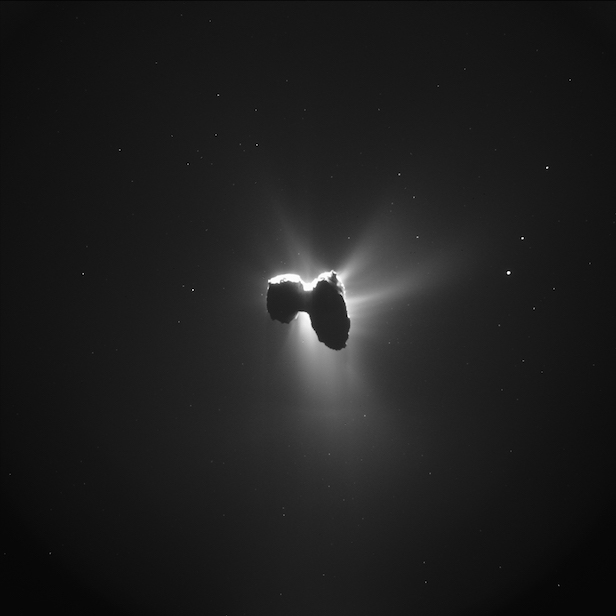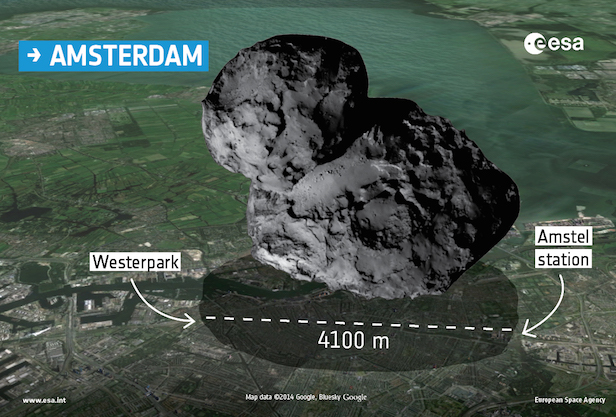Comet 67P could be younger than first thought
Computer simulations, combined with data from the Rosetta spacecraft, demonstrate that the comet could have been created after the formation of our Solar System

Rosetta first visited Comet 67P/Churyumov-Gerasimenko on 6 August 2014. Image credit: ESA/Rosetta/NavCam
Doubled-lobed comets, and in particular Comet 67P/Churyumov-Gerasimenko once visited by ESA’s Rosetta spacecraft, could be much younger than originally thought. New research shows that comets such as these were formed after catastrophic collisions of larger bodies, but they don’t necessarily constrain it to the early formation phase of the Solar System.
An international research group compared computer simulations they created to data taken from the Rosetta Orbiter Spectrometer for Ion and Neutral Analysis (ROSINA) spectrometer, developed at the University of Bern, Switzerland. These computer simulations investigated what happens after a collision of two large comet nuclei, and how they differ with different constraints. The aggregates had different shapes and sizes, many of which had many elongated and bilobed bodies, similar to Comet 67P.
“The calculations showed that a large part of the material accumulates in many smaller bodies,” explains Martin Jutzi of the Center for Space and Habitability (CSH) at the University of Bern. “We were surprised that in such catastrophic collisions only a small part of the material is considerably compressed and heated.”
While material is ejected from these cosmic collisions, their material hardly contributes to the formation of small bodies, creating a new generation of comet nuclei. Studies also show that on the side of the comet opposite to the point of contact, volatile substances can withstand these violent collisions. This would explain why the new generation of comets have such a low density, while still being rich in volatile substances, such as carbon monoxide, which has been spotted on Comet 67/P thanks to Rosetta. Consequently, we know that Comet 67/P, and other bilobate comets, was the result of a violent collision, but it did not have to occur in the early years of the Solar System’s formation.

The comparison in sizes between Comet 67P/ Churyumov-Gerasimenko and the city of Amsterdam. Image credit: ESA/Rosetta/NavCam/Google/Bluesky
Previous studies by Martin Jutzi, astrophycist at CSH, and Willy Benz, director of the National Centre of Competence in Research PlanetS, concluded that Comet 67P’s two-component structure didn’t form when the Solar System did 4.5 billion years ago. They acknowledged that the weak point between the two lobes of Comet 67P couldn’t have survived several billions of years, and it was created from a relatively gentle impact. The new results from this recent study have not only confirmed previous results, but have also presented more possible formation scenarios.
The computer simulations covered a variety of aspects, including different sizes of the bodies, different angles of impact and simulating speeds ranging from 20 to 3,000 metres per second (65 to 9,800 feet per second). It appears that the small fragments, expelled after the collision, converge in the following hours and days. The most fitting final shape to Comet 67P is the result of two or more large bodies colliding at very low speeds.
The simulations showed that bilobate comets are moulded in the following days and weeks after the collision, when its surrounding small fragments reaccumulate. Reality shows that the material could be flattened when it hits the surface, thus leading to a layered structure. Also, if large blocks formed near the surface of the comet, and then are drawn into the comet via its gravity, this can result in cavities and large pits similar to what was again observed by Rosetta. “Our results not only confirm that the comet Chury may be much younger than previously assumed, but also provide a possible explanation for its striking structures,” says Jutzi.
Keep up to date with the latest reviews in All About Space – available every month for just £4.99. Alternatively you can subscribe here for a fraction of the price!




